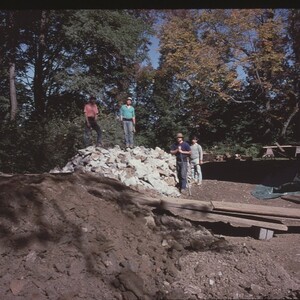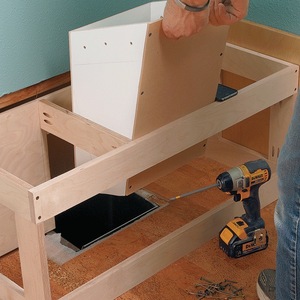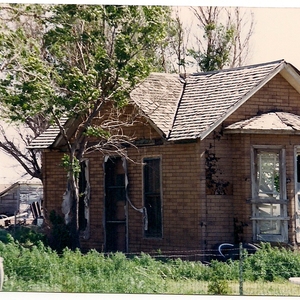Hey guys, I’m a homeowner, not a professional, so here is my question. I am using a Fuji 4 stage hvlp unit with a bleeder gun. I have pella clad doors and windows that I got half price because they were returns or wrongly ordered. Part of the price I had to pay was to take what ever color was available. Half my doors are wrong color and the others I ordered white. So I started with Zinser oil based primer, I was amazed how much I had to thin it with penetrol and paint thinner. After getting used to the gun I got a respectable finish with the oil based primer.
Next my problem. Here comes the latex colored by BM to match Pella white. After lots of flotrol and water it becomes thin enough (almost like water) to spray without spraying in clumps. Well, it starts orange peeling so I back off on the amount of paint entering the gun and then I can’t get a wet suface that will flow smooth, it seems to be powdery in places. One caveat, the orange peeling happened mostly at the first of the job when the gun wasn’t very hot, is that a factor to consider?
The gun was sent with a medium needle and since I got orange peeling I don’t think needle size is the problem. I can’t imagine thining it any more.
Overall I’m pleased with the job, as I could have never gotten such a fine finish with a brush, but the semigloss is not as shinny as on the new Pella White windows because of the powder finish.
Help is greatly appreciated.
Paul Denison


















Replies
It will be very hard to spray a thick latex like ben moore without a larger needle. I use a .072 and still thin it. The heat of the turbine is drying the paint when you cut back the volume of paint. The paint is probably thinned too much as well and going on dry.
Okay, Ill try the larger needle. I thought it looked too thin but it was orange peeling when it was thicker. Will the needle fix that?
Great artcle about HVLP sprayers in "American Woodworker" magizine. Solved all my problems with my new hvlp machine. Easy to understand and with clear instructions. If you can't find the magizine, call 715-246-4344 for copies of past articles. Have fun its a great new toy.
Your main problem was choice of paint. BM latex was intended and formulated for brush application. It will not make for happy carefree days trying to spray it through a HVLP unit. It can be done but it is work for an expert. This paint was also never intended for use in creating high grade finely textured surfaces. So you are fighting it's natural characteristics. Most professional shops would use a conversion varnish or catalyzed lacquer but these are pretty dangerous for homeowner use. I would reccommend something water base. I like "Breakthrough" but you have to get such paints at a professional finishing supplier. Another thing that works well is most of the polyurethane enamels and some alkyds too. You have to be very careful of the overspray with these though because they dry slowly.
Strikes me that something is really wrong here. I spray latex with a 3-stage (6 psi) turbine unit, also with "medium" needle (although a different tip set is recommended) with no problems or need for any Floetrol unless ambient temperatures are extremely high…………………and I don't even have to thin to recommended viscosity to get very excellent results.
That medium needle I'm referring to is a number 3 out of a range of 1-5. I have no experience with a Fugi turbine gun, but I'm suspecting something on the order of 8 psi with that 4 stage and I can't imagine that with latex, water and Floetrol that the generated air temps are causing your problems.
Your outfit should have come with a chart of recommended viscosities for various materials as measured with the use of a viscosity cup. You should be able to spray latex paint at the rated viscosity with a medium needle and expect at least decent results shooting full wet coats without resorting to the use of much, if any Floetrol.
Orange peel occurs when a full wet coat of material dries before it has time to level out. This can occur even if you are at recommended viscosity if/when you are spraying in windy conditions and/or exceedingly high temps. I doubt you're spraying in windy conditions with an HVLP turbine rig. And we can eliminate the use of an inappropriate thinner for the temp. conditions unless you're in a 140F attic or spraying on a heated surface. With water alone for the thinner this wouldn't likely be the cause and with the addition of a minimum amount of Floetrol……..most definitely not………unless your job site is deep in the desert. Orange peel IME is nearly unheard of with latex paint. It's something most often seen when shooting lacquers or shellac when the choice of thinners/reducers is far more critical in relation to the ambient temps.
From afar here………I'm suspecting that your problems are likely related to obstructed/deficient airflow to the gun head……………….. or that the check valve in the pressure tube from the gun head to the cup is plugged leaving you with a situation akin to/resembling siphon feed………only worse because with the check valve plugged, there is no easy air inlet either, for the necessary make-up air to the cup in a siphon-feed type situation.............and this condition has forced you to thin the material far beyond where you should have to in order to get enough to feed to the head.
FWIW, I've never had to add Floetrol to the stated levels on the container to achieve excellent results when spraying latex (even when spraying with siphon-fed high pressure gun) and I personally wouldn't recommend adding as much as suggested.
Edit: Plugged pressure tube check valve based on assumption that gun is not a "cup over head" gravity feed unit.
One more edit: Check the air-inlet filters on your turbine unit to see if they're plugged up. If they are, this would account for both the need to thin the paint excessively (obstructed airflow) and at the same time would lead to higher gun head temps resulting in a propensity for the material to orange peel.
Knowledge is power, but only if applied in a timely fashion.
Edited 10/27/2003 10:03:30 PM ET by GOLDHILLER
Edited 10/27/2003 11:17:12 PM ET by GOLDHILLER
Wow, thats a lot to think about. The needle I'm using is a 4 @.055. Would a 5 at .071 be better? I just started using the unit and don't think I'm having an airflow problem. I may have mislead you on the orange peel, the paint did level out but was still powdery looking. Maybe as Clay suggested it is a paint problem but I wouldn't know where to start with the other products he mentioned. So I'd like to try and solve the latex problem. The Fuji Q4 is 8 psi. Any other ideas?
If you check these links you'll find alot of info concerning your unit. Maybe you already have access to this. As you can see, Fuji recommends your very unit for spraying latex and the tip set you're currently running.
http://www.fujispray.com/fuji_products.htm
http://www.fujispray.com/technical.htm
I think there's a good chance that Lateapex911 may have struck on your problem...........maybe. Airflow adjustment is very critical when shooting HVLP. I see your outfit does indeed have an airflow valve in-line. My Wagner (Capspray)turbine unit has this valve located right on the side of the gun itself. Again..........proper adjustment of this valve is critical to good material feed and atomization............and that adjustment can be very sensitive. You'll likely need more airflow on your gun whenever you're spraying latex than any other common material. I rarely adjust the flow lower on my 6 psi unit for other materials either; once in a while if I need the absolute least amount of drift and overspray.
Getting that air adjusted can be tricky to the novice because what you see come out of the air-cap as you adjust it will be related to both the viscosity of material and the fluid needle flow adjustment. Too choked on material and you won't see the full effect of the air valve adjustment. Too open and you won't see the full affect either. There's some text on the linked Fuji site concerning this adjustment. And that text refers to orange-peel has a potential result of an overly choked air-flow.
Now check this potential mal-adjustment of the air-flow valve with your results to help discern the cause. Insufficient air-flow would cause/require you to overly thin the material to get it to feed into the head and.............would also cause orange-peeling.
I'd recommend that you first get your material adjusted to the suggested viscosity via the chart that should have come with your unit (hopefully it did) and the use of a viscosity cup. Then go for gun and air flow adjustments. Don't have your gun too far away from the surface you intend to coat. This can cause premature drying of the material before it hits the surface and be a cause of orange-peeling as well as dry "powder coating".
Let me know if you didn't get a chart with your unit and I'll post the recommended viscosities that came with my 3 stage unit and gun. While it may not be directly in sync with your guns performance, it should be close enough to get you started.
A word to the wise………..never discount the fact that a brand new piece of equipment can have problems. CAG had problems with his new HVLP unit here not long ago and it turned out that there was a broken brand-new airflow valve in his that didn't allow for full flow. He too, couldn't get the gun to perform properly until the problem was discovered and remedied.
I'm also a believer in heads-up behavior in the shop. When it comes to my spray equipment this means I tape over the end of the hoses and the gun inlet if the two are separated to prevent bugs from crawling inside during periods of inactivity even if this is only overnight. An ounce of timely prevention can save hours of tearing your hair out later. Tape is cheap.
Edit: I presume you're filtering your paint.....???? An old nylon (check for holes or tears) work excellent for paint as they will allow you to squeeze the material through withut waiting forever and filter the material fine enough to eliminate anything that will cause problems.
Knowledge is power, but only if applied in a timely fashion.
Edited 10/28/2003 9:21:09 AM ET by GOLDHILLER
Edited 10/28/2003 9:24:32 AM ET by GOLDHILLER
I spoke with a technical rep from Fuji. He was very helpful. Evidently I have the recommended needle, a 4 at .055. Anything larger will not give a fine finish. He still recommended using the flowtrol, but not too much, and try not to cut the paint too much as this will cuase it to dry too fast and casue it to not flow out well. He also suggested trying a higher gloss as the flowtrol will dull the gloss a little. He said that I should not worry too much about getting the paint attomized too much as it may flow better and not dry too fast if it goes on a little thicker. I think I need to work on the proper balance between pattern, air and paint thickness. I also have the 800 Pella number to talk to the factory about paints they use. Oh, my air valve seems to be acting properly. Thanks for all the help.
Paul, do you have the book that came with the unit? It mentions that latex needs to be thinned to flow through their provided Zahn Cup, with their #4 assembly, at 40 to 50 seconds. This is the recommended flow rate when reduced with Floetrol (Flood Chemical). I used this gun with their 4 stage assmebly, although with oil, and it worked fine. I believe you can find their "User Manual for HVLP Systems, Fuji" as a PDF document on their website.
Usually a larger tip will not give as fine a finish but most paints designed for a fine finish are much thinner than latex house paint. The latex will level out fine if sprayed through a larger needle set up. I use it when I have to use latex house paint and it works fine even though latex is not the ideal choice for the spraying I do. Try the fuji advice first since it wont cost you anything, but dont believe them when they say you cant get as good a finish with the larger tip. The paint you are using(latex house paint) will limit the level of finish you get more than the needle. It is meant to be brushed so it will level out fine with the larger tip.
Also, and I'm sure you've checked this, but the Fuji system I have (4 stage), has a valve on the hose. It should be opened fully for heavy materials.
The Fuji is a bit dicey to clean, and the passages can get plugged easily. Double check before getting desperate!
Jake Gulick
[email protected]
CarriageHouse Design
Black Rock, CT
Paul, from what I can gather you used oil-based paint. Aside from perennial drying time it is not too fit for spraying. Finishes work under at least three parameters:
Temperature of paint, gun and environment
Air rate (compressor big nugh, high volume...), air change rate of spray-chamber, booth
Moisture (outside air, inside air - of course no moisture in the pressure system).
I would have recommended a 2 component PUR-system paint. You can add "Verzögerer" ( retarder) to give the paint more time to dry. But done is done.
Oil based paints are formulated for the brush or roller. They are made to flow...not spray. So much bfrom Germany, Mathias http://www.raulfcarpenters.com
Matt,
I took a little tour of your website. You've done some very attractive work!
Knowledge is power, but only if applied in a timely fashion.
Thank you very much. Mathias
Try this web page also. http://www.toolcenter.com/TURBINAIRE/Operators%20Manual%2098.html#3.1
Results of advice follow. I called Pella who said that Sherwin Williams had their paint formulas. SW has the interior colors but not the exterior, so they tried a match off of a pella card. Good news and bad. The good news is that SW's paint, a gloss meant to be applied over metal, an acrylic latex, did a much better job as far as appearance goes. I did not use flotrol and only thinned with 2 tbls of water per quart. The paint went on wetter and I got a much better sheen. The bad news is that "moma" is not happy with the color match. I told her that we would be the only ones who would ever notice! I still have a lot to learn on using HVLP. Thanks for all the advice
Look here to see if any of this is of interest to you. Overall I am sure you will get it perfect with practise.
http://www.thewindowman.co.uk/pvcu-colours-finishes.htm